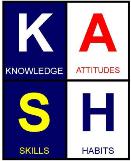The KASH Box

During several of our seminars we often project the illustration shown here on the right. Upon noticing it, the most common question is: “What is this?”
This is referred to as the KASH Box and as we explain its purpose and meaning, the listener usually nods their head and smiles. They often said, “I’ve believed this for years, but I never saw it expressed this way. Seeing it reinforces what I’ve always known.”
Consider the four sectors of the square marked, Knowledge, Skills, Attitudes, and Habits. Consider each as attributes to an individual’s success either at work or in life in general. In most cases, when someone fails, why? Most respond failure can be attributed primarily to attitudes and habits, not skills and knowledge.
Consider Hiring
I was once involved in hiring a team leader for a customer service department. There were several of us who interviewed the candidates. We looked for someone who had sales experience in a customized engineered product. The individual who we finally selected met all the criteria in terms of experience, knowledge, and, selling skills. Within a few days of his starting date, we began to see issues. He was quite convinced that he knew all that needed to be known to be successful in his new position. He was in a telling mode, not a learning mode. He was often late for work and left early because of personal issues. Here was a person who apparently had the knowledge and skill to be successful, but poor habits and an unproductive attitude. Within a month, the decision was made to let him go. When we discuss the KASH box with people they very often can relate a similar story,
A friend of mine is in the middle of selecting a new graphics marketing person for his group. I offered to help with the selection process by screening the candidates for attitudes and habits. He discussed it with his committee, who had previously selected a process which included some Power Point development and graphics design exercises. I am sure that they will be able to make a good decision on the candidate’s skills and knowledge, but how will they work with others within the group? Will they be challenged by the projects they will be assigned or find them mundane and not worthy of much effort?
Coaching and Motivation
We have had the opportunity to coach many business and community leaders recently through the interview and selection process. Our efforts were to equip them with good open-ended questions to be used in discussion with the candidates. These questions were derived by an evaluation method used to better understand a person’s motivators and attributes. Our success rate has been outstanding.
 The KASH box idea does not only apply to the practice of hiring employees, but is equally applicable in considering the productivity of existing work groups. A student of mine recently was promoted to a leadership role for a work group in a county government department. After a week in the new position, she reported that it was going to be difficult to improve productivity. The people in the group have years of experience in their jobs and had the skills to perform them. On the other hand, most were approaching retirement and were just counting the days. The challenge for this first time supervisor was to change attitude and habits. This would be a tough assignment for an experienced manager. She will need some coaching and mentoring to make this happen. The key to success is identifying the problem.
The KASH box idea does not only apply to the practice of hiring employees, but is equally applicable in considering the productivity of existing work groups. A student of mine recently was promoted to a leadership role for a work group in a county government department. After a week in the new position, she reported that it was going to be difficult to improve productivity. The people in the group have years of experience in their jobs and had the skills to perform them. On the other hand, most were approaching retirement and were just counting the days. The challenge for this first time supervisor was to change attitude and habits. This would be a tough assignment for an experienced manager. She will need some coaching and mentoring to make this happen. The key to success is identifying the problem.
One of the keys to business success in organizations is the selection and motivation of people. The belief by many is that the selection process is a gamble and the motivation process is impossible. Coaches, using an understanding of the KASH box, can reduce the risks in the gamble and make the impossible possible.
